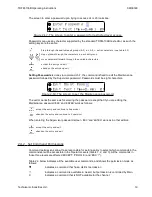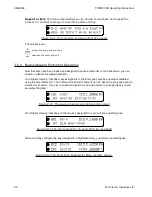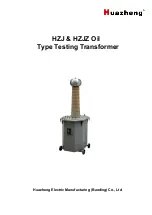
TDFM-136B Operating Instructions
08RE399
Editing analog squelch modes
For
analog receive noise squelch
the screen to change the value appears as follows:
Figure 2-7. The noise squelch edit screen
.
Note that the cursor drops to the bottom row, ready to edit, for noise squelch, the editor operates
as follows:
to
decimal mode: enter number, cursor automatically advances
accept the entry and continue
abandon the entry and exit
If editing the receive value, when you press
“ENTER”
to continue, the editor returns to the first
screen, but the Transmit/Receive indicator character (second last character on the line) has
changed to a “T” to indicate that you are editing for transmit. This allows you to set 'duplex values
for the selective squelch (ie transmit may be different than receive). The screen to select a transmit
squelch mode appears as follows:
Figure 2-8.
The screen to edit the Main Squelch Mode for transmit.
The edit keys are the same as for the first screen.
Note that for analog modes “Tx” indicates that no selective squelch will be used, there is no value
associated with the “x” choice for transmit.
For
analog CTCSS Tone squelch
the user would have to select 't' in the initial screen (in analog
modes only), if so then the editor to change the value would appear as follows:
Figure 2-9. The CTCSS Tone squelch edit screen
.
The editor works as follows:
step up/down through available tone choices
accept the entry and continue
abandon the entry and exit
See Appendix B for the table of CTCSS tones supported.
Technisonic Industries Ltd.
13
001 Control w136.0000Rx
Noise Level: 10
001 Control w136.0000Tx
Edit Sql Mode (|~9,#*)
001 Control w136.0000Rt
CTCSS Tone: (|~,#*) 67.0
















































